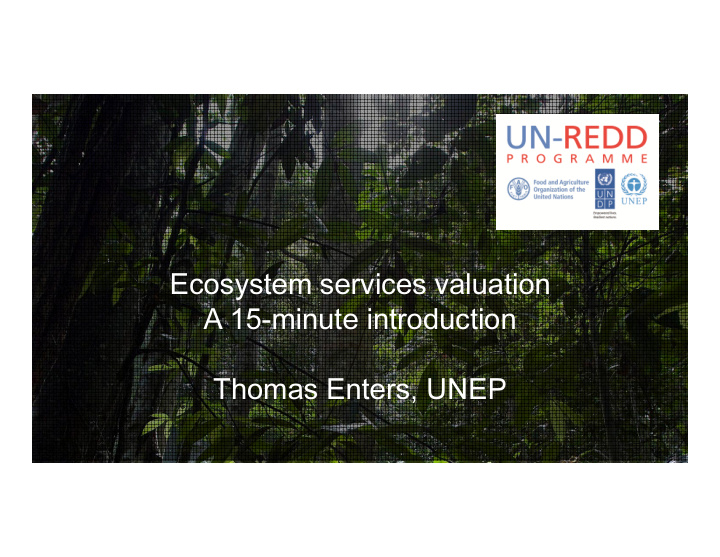



Ecosystem services valuation A 15-minute introduction Thomas Enters, UNEP
Common assumption • Undervaluation of ecosystem goods and services has discriminated against their sustainable management and conservation. They have therefore long been underemphasized or ignored altogether by planners and decision-makers because they are so hard to value, and because many lie outside formal markets and pricing mechanisms.
Types and classification of ecosystem services The benefits that people obtain from ecosystems. Although goods, services and cultural services are often treated separately for ease of understanding, the Millennium Ecosystem Assessment considers all these benefits together as “ecosystem services”.
Values of ecosystem services Even in the same country or region huge differences of individual direct use values have been observed (e.g. non-timber forest products range in Cambodia from less than US$5/ha/year to over US$160/ha/year)
Valuation methods The process of expressing a value for a particular good or service in a certain context (e.g. of decision-making), usually in terms of something that can be counted. Values are often monetary.
An example from Japan Value of forests Ecosystem service in billion US$/year CO 2 absorption 10.8 Substitute for fossil fuels 2.0 Prevent surface erosion 245.7 Prevent loss of topsoil 73.4 Ameliorate flooding 56.2 Conserving headwater resources 84.7 Purify water 127.3 Health and recreation 19.6 Total 619.7 How were the results used? • In Kochi prefecture, inhabitants and businesses were charged (up to US$800) to fund restoration and enhancement of forest ecosystem services that were being lost and led to serious forest degradation.
An example from Belize Value of coastal ecosystems (reef and mangroves) Value for year of forests Ecosystem service in million US$ in 2007 Remark Tourism 150 to 196 Contribution to Belize economy Fisheries 14-16 Annual economic benefit Protection from erosion and wave damage 231-347 Avoided costs per year Total 395-559 How were the results used? • Advocate tougher fishing regulation and amendment to mangrove legislation (illegal clearing). Calculate damages for compensation after a container ship grounded on the barrier reef.
What to look out for or ask! • Discount rate • Time horizon • Financial and economic analysis use different prices • Solid understanding of physical processes • Goal (purpose or context) • Process
Choice of discount rate • A 100-year project, yielding benefits of US$22,000 on completion, is worth around US$8,000 today using a 1% rate, but only US$1 at a 10% rate. • A high discount rate reflects a strong preference for present consumption, and a low discount rate reflects long-term considerations and preferences. • Private and social discount rates (often 10% is used) are not the same. • Choice is often not explained.
Choice of time horizon • Often values are only calculated for one year, while there may be substantial differences over time, especially regarding prices. • If a longer time horizon for the calculation of the net present value is used, the choice is often not explained.
Type of analysis • Financial or economic analysis • Often it is not clear whether market prices, social costs or shadow prices have been used. • Choice is often not explained. • There are also shadow exchange rates where currencies are over- or undervalued.
Quantifying ecosystem services in physical terms • There is a lack of information on ecosystem services. • Understanding of biophysical processes and causes and effects is often weak, especially for regulating services. • There is often quite a big difference between conventional wisdom and scientific evidence, e.g. for the flood mitigation value of forested watersheds.
Goal, communication and process • If the goal (or purpose or context) of the valuation exercise is not stated the results may be meaningless and/or misunderstood. • Information on the economic value of ecosystem services has little relevance if it is not being communicated effectively to decision-makers, in a form that is practical, relevant and credible to them. • Lack of an inclusive multi-stakeholder approach reduces the value of the valuation significantly.
The power of opportunity costs (financial) • We show that converting a hectare of forest for palm oil production will be more profitable (yielding net present values of US$3,835–US$9,630/ha over a 30-year period) to land owners than preserving it for carbon credits (US$614– US$994), in Butler et al. 2008. • Will accounting for all ecosystem services make the difference? • Average figure for forest env. services in Mekong Basin: US$1,281/ha/year over 25 years, discount rate 10%.
Useful resource The economic value of ecosystem services in the Mekong Basin: What we know, and what we need to know. Prepared by WWF, 2013.
A final thought “In fact, being able to present the net worth of songbirds, pine kernels and all the other elements of the biophysical and spiritual environment, continue to be viewed by many as an important tool for rational, informed and effective decision making. And people continue to come to economists in search of emotional and political satisfaction, as Paul Krugman wrote in 1999. But in many cases the problems are of a moral, aesthetic, cultural and political nature and not of an economics nature, as Mark Sagoff wrote in 1988.”
Thank you! Effect of losing an REDD+ ACADEMY ecosystem service
Recommend
More recommend